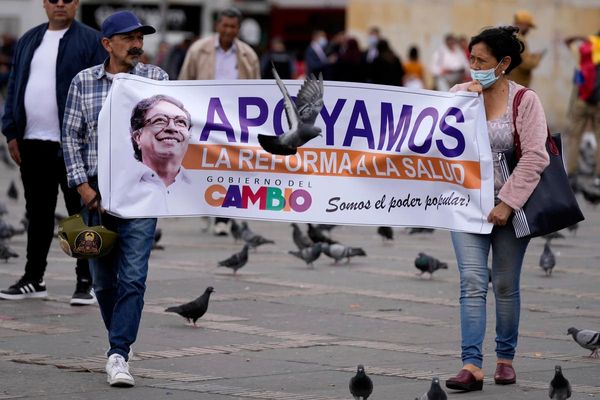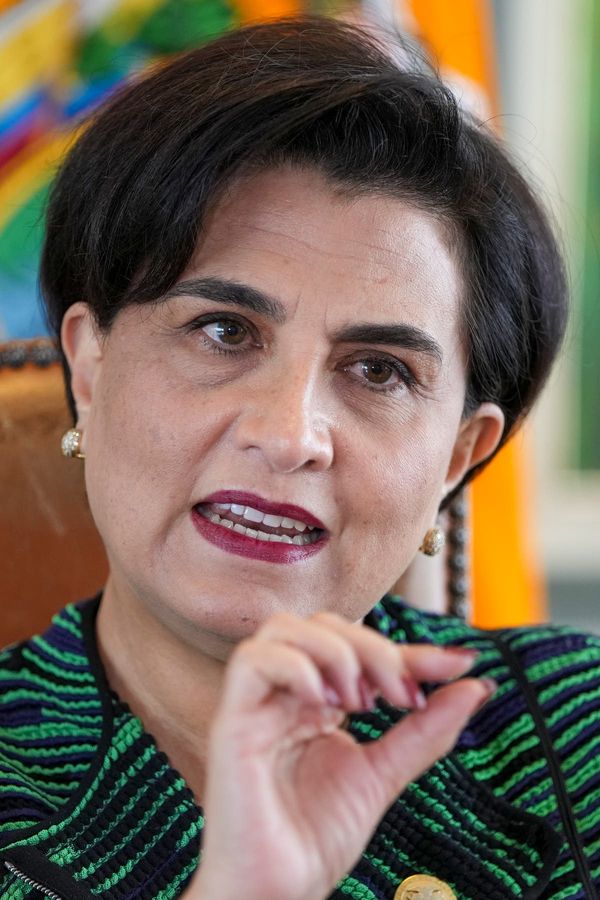A heap of tomatoes gleams in the light as do the tub of chillis beside it, while the shop’s proprietor, wearing a shirt that nearly matches the colour of the tomatoes, looks sagely on. It feels like an idyllic scene out of small-town India, a pictorial representation of a ubiquitous kirana store, the mainstay of local inhabitants. And yet, the story behind the photograph, one of the many currently being exhibited at Chitrakala Parishat, is so much more.
“That picture is of a man whose farming had failed,” points out documentary photographer and filmmaker, Arjun Swaminathan, who has captured this image. “His natural adaptation to this was to keep a grocery store,” adds Mr. Swaminathan, the director of Native Picture, an organisation that focuses on documenting the lives and issues faced by common people.
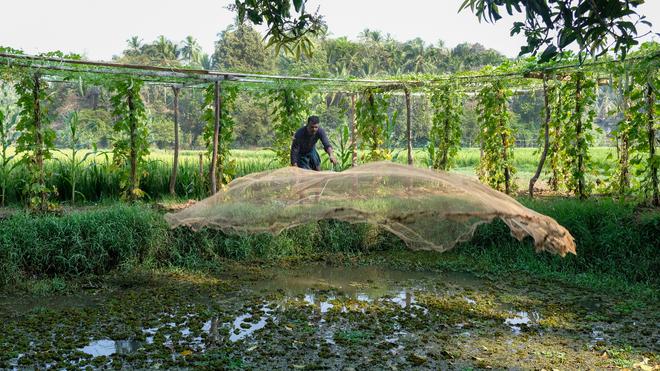
Ways of adaptation
This man is one among many in Kozhikode, Kerala, who has been directly impacted by climate change, and found ways to modify his existence in response to it, without external intervention. “It is called autonomous adaptation to climate change,” points out Kalaiarasi Ka Sa, a project associate at the National Institute of Advanced Studies (NIAS), Bengaluru, which is spearheading this photo exhibition titled But Man is not made for defeat, a title derived from a line in Ernest Hemingway’s 1951 allegorical novella, The Old Man and the Sea.
Staying true to the central theme of Hemingway’s novella, this nuanced, powerful photo essay is a testament to people’s struggle and triumph over nature. Part of a larger study under the inequality and Human Development programme by NIAS, headed by Professor Narendar Pani, the exhibition looks at “climate change as a process,” points out Ms. Kalaiarasi. “We thought we would look into the adverse effects as well as the growth opportunities,” she says.
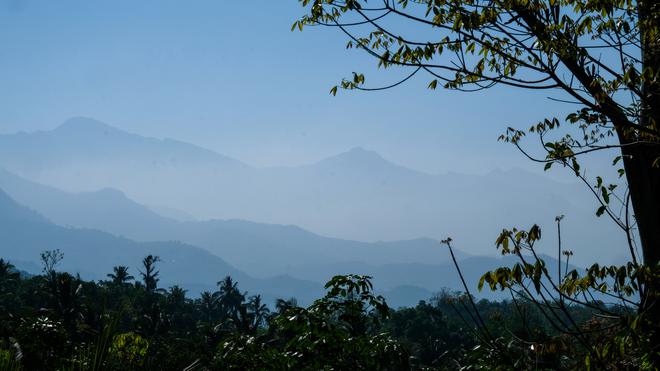
Part of a larger study
“The discourse around climate change always focuses on extreme events. Only when something hits, we will think about it,” points out Nisar Kannangara, a postdoctoral associate at the Inequality and Human Development Programme. There are actually two effects of climate change -- extreme events, yes, but also long-term events, he points out. “In the last three decades, there have been minor changes in temperature. The effect of that on people hasn’t been reflected in research so far,” he says.
This study, conducted by Mr. Kannangara and Ms. Kalaiarasi, and supported by TCS, explored the more long-term effects of climate change. By looking at the meteorological data of various Indian districts, collected over decades, the researchers discovered that Cachar in Assam and Kozhikode in Kerala were the two places most exposed to multiple climatic events, both long-term trends in key parameters like temperature and precipitation and associated events like floods, heatwave, and droughts. They looked into just exposure while mapping, says Ms. Kalaiarasi, “We then tried to integrate trends in complex phenomena like extreme rainfall events and cyclones.”
Kozhikode in focus
Kozhikode was finally chosen for fieldwork because of the complexity of its terrain. “It had different terrains which Assam did not have,” points out Mr. Kannangara. Three places were chosen for this, extensive ethnographic research study -- a coastal village, a midland village, and a hilly area-- and he spent around six-odd months overall in these villages, talking and building a rapport with local inhabitants. “When I asked people in the coastal village about climate change, they told me no one was experiencing it,” recalls Mr. Kannangara. “They told me that I had to go to Thiruvananthapuram or Thalassery for that.”
And yet, on further interaction, he discovered that the village’s natural harbour had washed away, thanks to climate-change-induced coastal erosion. This coupled with a fast-changing fishing environment -- bigger boats, more advanced nets, government interventions, and a volatile religiopolitical situation — had completely altered the livelihood narrative in this region over the past three decades or so. “People today have to wake up early morning, get into a truck, and travel 15-20 km to the new harbour,” he points out, adding that not everyone was able to cope with these changes. “Older people and women were left behind.”
In the two other areas too — the midland village where paddy was traditionally cultivated and the hilly area, which was once home to large rubber plantations — climate change has had a sizeable long-term effect, and not necessarily all negative.
For instance, while prolonged monsoons and unseasonal rain, courtesy of climate change, have led to flooding and algal clogging, changing the agricultural ecosystem completely, it has been beneficial to the Pulaya community. The feudal tenancy system was upturned when educated, upper-class farmers abandoned their land due to the lack of viability of agriculture, points out Mr. Kannangara. “The paddy field became more democratic,” he says, adding that these people, mostly tillers who hadn’t benefitted much from the Green Revolution or land reforms, began cultivating this vacant land. “We call it opportunity in distress,” he says.
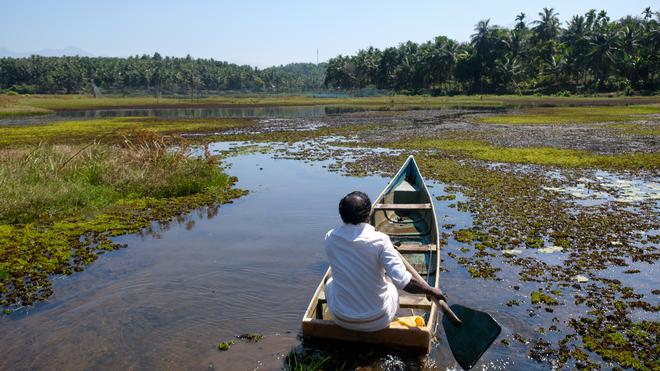
At the exhibition
One of the things that struck Mr. Swaminathan the most was the fissures in the communities he visited and photographed. “I found that lines were drawn in these rural communities. Caste lines, class lines…” says Mr. Swaminathan, who spent a week or so shooting these communities and the landscapes they inhabited.
One can see the complexity of community dynamics segueing into the photo story too. Interspersing the photographs depicting livelihoods — boat-studded seascapes, tangled fishing nets, lush green fields filled with paddy and bordered with coconut palms, honey extraction at an apiary, and rubber trees oozing milky latex—are others with more ominous subtexts, indicative of a fractured society.
In one, for instance, two large photographs of boats rest side by side, with one boat bedecked with a saffron flag and another with a green one, to depict the communal polarisation between the Hindu Mukkuvan fishermen and Puslan Muslim ones. In another, a communist flag flutters in a tree-filled landscape.
“Climate change causes social and political transformations,” says Mr. Kannangara, who believes that this aspect has not been explored enough. Often, too often, Indian policy is shaped but the global climate change discourse, but there are things happening on the ground that are not being reflected in the policy, he says. “There is a huge realm of inequality in the knowledge of climate change,” he says. Climate change does not simply come and hit a plain canvas; it is more complex than that. “We are trying to understand the larger process,” he says.
(But Man is not made for defeat is being exhibited till July 24 at Chitrakala Parishath, Bengaluru, till 5.30 p.m.)

